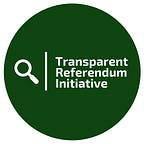Questions we’re working on part 2: When is an ad political?
By Liz Carolan
A statement caught my eye today, attributed to Richard Oakley, editor of the The Times Ireland Edition.
He (Oakley) insisted the Facebook posts were promoted articles, not ads. (Irish Independent)
I’ll come back to what “the Facebook posts” were in a moment, but I want to focus in on the distinction being made here between promoted articles and ads. This may be a paraphrased statement, but it isn’t the first time I’ve come across it, and to me it is the wrong distinction.
What matters more in the context of social media is whether paid content is political or commercial.
This may sound pedantic, but bear with me — it has implications for how we think about regulating political activity online. It is also something we at TRI have been thinking about as we try to build a database of political (but not commercial) ads.
When it comes to TV and radio, we long ago decided not to allow political advertising. We made a distinction between advertising products and using money to attempt to influence the behaviour of voters.
That distinction is about the intent of the content; is it trying to sell socks or buy votes.
A major issue with social media advertising is that it does not make this distinction.
The intent in promoting the articles Oakley was referring to above is brand building; attracting new readers who might then pay for a subscription or generate revenue via clicks. This is an important and legitimate business model for media companies in 2018.
The newspaper paid Facebook to show some users content to grow their business. In that sense it is an advertisement, a commercial one. Selling socks not buying votes.
This case made a ripple because the promoted article was about the 8th Amendment and had an anti-amendment slant. The paper paid Facebook to show it to a range of people in Ireland they thought might find it interesting, targeting “anyone with views around childbirth, midwives and those who hold pro and anti views on abortion/women’s rights issues” (Oakley again in the Independent).
Facebook has a transparency tool that lets you know why you were chosen to see a particular “ad”. This is generally a useful tool as it gives an individual the right to know why they are seeing something.
In this case however, a person was told they were “seeing this ad” because the newspaper “wants to reach people interested in anti-abortion movements ”.
This got picked up by pro-amendment/pro-life campaigner John McGuirk, who saw why this one user was seeing the ad and posed a question as to whether this counted as political advertising.
Oakley’s explanation — that the intention was commercial not political — was accepted by McGuirk, though not before time, energy and trust in our media had been somewhat expended.
Partial transparency is better than no transparency, but it does make it difficult to understand why ads are being placed. In cases like this that makes it difficult to determine if they are political or commercial.
The Times Ireland Edition aren’t the only paper targeting users with referendum relevant content — the tool we are currently testing to identify political ads has picked up that the Irish Times is targeting “people who have visited their website” with a “Subscriber only” editorial on the 8th (shown below).
The Irish Times’ intention here appears similar to that of the Times, building a subscriber base. Closer to selling socks than political advertising.
But as it involves paying to promote content relevant to the referendum, it is likely to be picked up by any tool we develop to filter commercial from political ads. (See my previous post).
We, like McGuirk and those who saw his tweet, will only have a partial snapshot of why people are being targeted, so intent will be difficult to discern. In the case of us building our database, I think our approach will have to be to include content where we cannot discern intent.
This might be a technical challenge for our initiative, but it is a bigger problem when we think for the law. How can we legally differentiate between commercial and political ads online?
Intent will be key. And as we have seen, in the absence of full transparency by the platforms on who is being targeted and why, intent will be difficult to discern.
